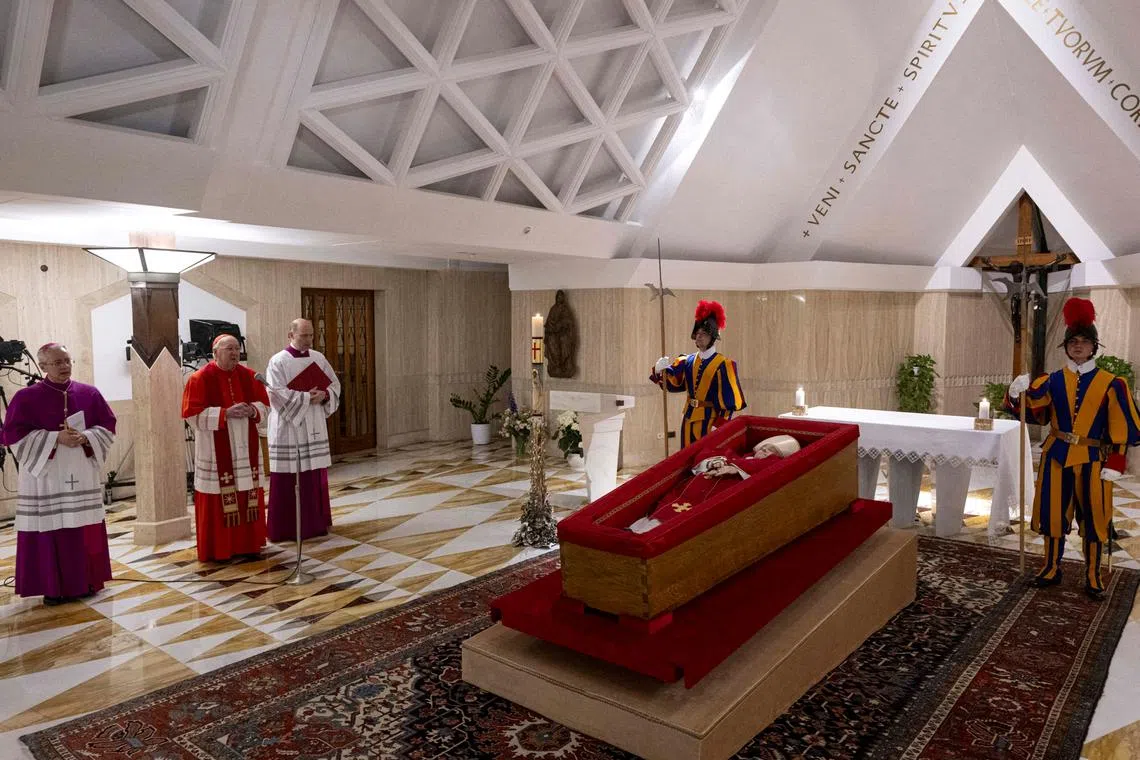Pope Francis’ funeral to be held on April 26, many world leaders expected
Sign up now: Get ST's newsletters delivered to your inbox

The Vatican on April 22 released photos of Pope Francis dressed in his vestments and laid out in a coffin in the chapel of the Santa Marta residence.
PHOTO: REUTERS
Follow topic:
VATICAN CITY – Pope Francis’ funeral will take place early on April 26, setting the stage for a solemn ceremony that will draw leaders from around the world.
Pope Francis, 88, died unexpectedly on April 21 after suffering a stroke and cardiac arrest,
According to the death certificate released by the Vatican, the pontiff died of a stroke, resulting in a coma and “irreversible” heart failure.
The certificate also revealed he had Type 2 diabetes, which was not previously public knowledge.
Pope Francis spent five weeks in hospital earlier in 2025 for double pneumonia.
The Vatican on April 22 released photographs of Pope Francis dressed in his vestments and laid out in a wooden coffin in the chapel of the Santa Marta residence, where he lived during his 12-year papacy.
His body was to be taken to the adjacent St Peter’s Basilica at 9am (3pm Singapore time) on April 23 in a procession led by cardinals, allowing the faithful to pay their last respects to the first Latin American pope.
His funeral service will be held at St Peter’s Square, in the shadow of the basilica, at 10am on April 26.
US President Donald Trump, who clashed repeatedly with the Pope about immigration, said he and his wife would fly to Rome for the service.
Among other heads of state set to attend were President Javier Milei from Pope Francis’ native Argentina, Brazilian President Luiz Inacio Lula da Silva and Ukrainian President Volodymyr Zelensky.
In a break from tradition, Pope Francis confirmed in his final testament released on April 21 that he wished to be buried in Rome’s Basilica of Saint Mary Major
His sudden death set in motion ancient rituals, as the 1.4 billion-member Roman Catholic Church started the transition from one pope to another, including the breaking of the Pope’s “Fisherman’s Ring” and lead seal so they cannot be used by anyone else.
All cardinals in Rome were summoned to a meeting on April 22 to decide on the sequencing of events in the coming days and review the day-to-day running of the Roman Catholic Church in the period before a new pope is elected.
A Conclave to choose a new pope normally takes place 15 days to 20 days after the death of a pontiff, meaning it should not start before May 6. Some 135 cardinals are eligible to participate in the highly secretive ballot which can stretch over days.
At present, there is no clear front runner
Progressive
Pope Francis inherited a Church in disarray and worked hard to overhaul the Vatican’s central administration, root out corruption and, after a slow start, confront the scourge of child abuse within the ranks of the priesthood.
He often clashed with conservatives, nostalgic for a traditional past, who saw Pope Francis as overly liberal and too accommodating to minority groups, such as the LGBTQ community.
Pope Francis appointed nearly 80 per cent of the cardinal electors scattered across the world who will choose the next pope, increasing, but not guaranteeing, the possibility that his successor will continue his progressive policies.
Many of the cardinals are little known outside their own countries.
They will have a chance to get to know one another at meetings known as “general congregations” that take place in the days before a Conclave starts and where a profile of the qualities needed for the next pope will take shape.
The Vatican said late on April 21 that staff and officials within the Holy See could immediately start to pay their respects before the Pope’s body at the Santa Marta residence, where he set up home in 2013, shunning the grand, apostolic palace his predecessors had lived in. REUTERS

